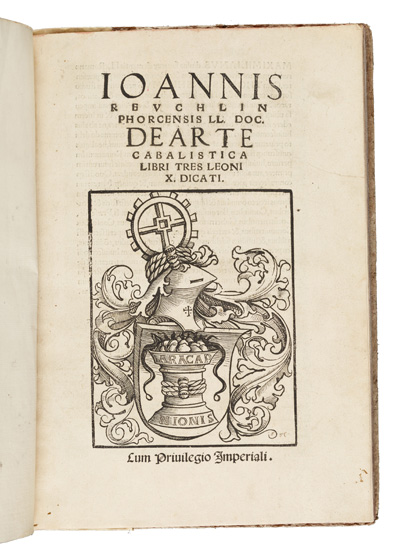
Overall, when assessing Reuchlin’s thought, it is important to note that he never departed from the then orthodox principle that Christianity was the one true form of religion; thus, in his eyes, Judaism could never be fully equal to Christianity. Nonetheless, his writings on Judaism evince, over time, a growing willingness to affirm elements and examples of Jewish theology and piety. This was a gradual development, but one that we can detect as Reuchlin expressed successively higher levels of appreciation as he wrote Rudiments of Hebrew (1506), Eye Glasses (1511), and Art of the Kabbalah (1517).

Reuchlin did not formulate a theology or philosophy of toleration, but he did defend Jewish life in two effective ways: he meticulously asserted the legal rights of Jews and the legality of Jewish writings, and, more distinctively, he created a new Christian discourse that represented Jews and Judaism favorably, thereby not only invoking a concept of justice for Jews (in accord with his general principle that "injustice is a monstrosity"7) but also encouraging Christians to develop respect for the beleaguered minority and its religious heritage. In his 1517 Art of the Kabbalah (a book dedicated to Pope Leo X), a Christian scholar proclaims a rabbi "our glory," expressing admiration for the Jew’s piety and learning.8 Indeed, the writer Max Brod, literary executor for the estate of Franz Kafka, characterized Art of the Kabbalah as "a work in which he dared to say more and more substantial things to benefit the persecuted Jews and their disdained and misunderstood intellectual champions than in all of his earlier works combined."9 In a book of 1519 (on the ancient Christian exegete Athanasius), Reuchlin repeatedly cited the Jewish philosopher Maimonides as the most significant theological authority on such fundamental topics as the nature of God and the relationship of the soul to God.10 The elevation of Jewish scholarship was a purely academic judgment but it ultimately fostered Reuchlin’s creation of a new discourse of Christian admiration of the Jewish tradition and individual Jews. In Eye Glasses, Reuchlin had the temerity to criticize the misguided prayer for the "perfidious Jews" in the Good Friday liturgy with the assertion that no people observe their religion as faithfully as do the Jews. In 1513, he went so far as to proclaim: "I know my enemies have been vexed because I said the Jews are our fellow citizens. Now I want them to rage even more in anger ... because I am saying that the Jews are our brothers."11 When, in 1514, he published a letter that addressed his first Hebrew teacher, Rabbi Jacob ben Jehiel Loans, as "My Lord, dear master Jacob, my companion, and my good friend, … with deep longing I wish to see your blessed face to delight in the radiance of your bright countenance by hearing your most pure doctrine,"12 Reuchlin was redefining the boundaries for Christian representation of Jews and Judaism, and defiantly so since he was already embroiled in the heresy trial. He included the letter to Loans in an anthology that featured correspondence with such eminent Christian scholars as Erasmus, Willibald Pirckheimer, Giles of Viterbo, and Aldo Manuzio. After this letter appeared, Johannes Pfefferkorn attacked it as yet another intolerable example of Reuchlin’s favorable treatment of Jews and Judaism.13 Despite that and despite the travails of the ongoing heresy trial, Reuchlin republished the letter with a Latin translation in 1519.14
7. See Reuchlin, Defensio (1513), in Sämtliche Werke 4/1:342.
8. See Johannes Reuchlin, De arte cabalistica (Hagenau: Thomas Anshelm, 1517), fol. O7v.
9. Max Brod, Johannes Reuchlin und sein Kampf (Stuttgart: Kohlhammer, 1965), 271.
10. Johannes Reuchlin, trans., Liber S. Athanasii de variis quaestionibus (Hagenau: Thomas Anshelm, 1519), esp. fol. I3v and N1r. Reuchlin quoted Maimonides’ Guide for the Perplexed some ten times (in Hebrew with Latin translation) in his annotations to this text he attributed to Athanasius.
11. Reuchlin, Defensio (1513), in Sämtliche Werke 4/1:344, ll. 19-25.
12. Johannes Reuchlin, Briefwechsel, ed. Matthias Dall’Asta and Gerald Dörner (Stuttgart-Bad Cannstadt, Frohmann-Holzboog, 1999- ), 1:338 (no. 105, 1 November 1500).
13. Johannes Pfefferkorn, Defensio (Cologne: Heinrich Neuß, 1516), fol. O3v.
14. The letter was reprinted in Latin and Hebrew in Illustrium virorum epistolae, ed. Johannes Reuchlin (Hagenau: Thomas Anshelm, 1519), fol. m1r.